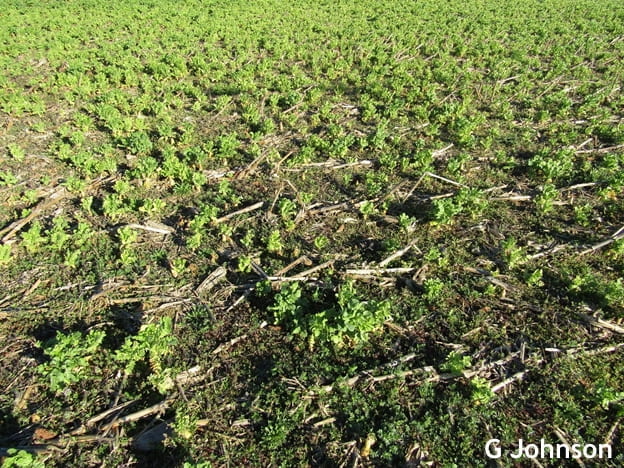Gordon Johnson, Extension Vegetable & Fruit Specialist; gcjohn@udel.edu
Cover crops that put on significant growth in the fall and then die during the winter can be very useful tools for vegetable cropping systems. These winter killed cover crops add organic matter, recycle nutrients, improve soil health, and allow for earlier spring vegetable planting.
Winter killed cover crops that are late-summer and early-fall planted include spring oats, several mustard species, and forage and oilseed radish. Earlier planted summer annuals (millets; sorghums, sudangrasses, and hybrids; annual legumes such as cowpeas or forage soybeans; buckwheat and many others) can also be used as winter killed species. Timing of planting will vary according to the species being used and winter killed species selection will depend on when fields will be available for seeding. Summer annuals should be planted in August for use in a winter killed system to obtain sufficient growth.
Spring oats and mustard species can be planted from late August through September. For best effect, forage and oilseed radishes should be planted before the middle of September. Spring oats, radishes and mustards are not suited for October or later planting because they will not produce adequate fall growth.
The winter killed non-legumes mentioned above will benefit from the addition of 30-60 lbs of nitrogen.
The following are several options for using winter killed species with vegetables:
1) Compaction mitigation for spring planted vegetables. Where there are compacted fields, the use of forage radish has worked very well as a winter killed cover crop by “biodrilling”. The extremely large taproot penetrates deep into the soil, and after winterkilling, will leave a large hole where future crop roots can grow. Oilseed radish also provides considerable “biodrilling”. Winter killed radishes works well with spring planted crops such as spinach, peas, early sweet corn, and early snap beans. One issue with radishes is that on mild winters they may not fully winter kill. A potential winter kill mix would include a radish, a mustard, and spring oats.
2) Early planted vegetables. A wide range of early planted vegetables may benefit from winter killed cover crops. For example, peas no-till planted or planted using limited vertical tillage after a winter killed cover crop of forage radish, oilseed radish, or winter killed mustard have performed better than those planted after conventional tillage. Early sweet corn also has potential in these systems as do a wide range of spring vegetables including spinach, potatoes, and cabbage. Winter killed radishes and mustards also have the advantage of outcompeting winter annual weeds leaving relatively weed free fields and recycling nutrients from the soil so that they are available in the spring for early crops (decomposition has already occurred).
3) Mixed systems with windbreaks for plasticulture. By planting planned plasticulture bed areas with winter killed cover crops and areas in-between with cereal rye you can gain the benefits of these soil improving cover crops and eliminate the need make tillage strips early in the spring. The winter killed areas can be tilled just prior to laying plastic.
4) Bio-strip till. By drilling one row of forage or oilseed radish and other adjacent rows with rye or other small grains, you can create a biodrilled strip that winter kills and that can be no-till planted into the spring without the need for strip-till implements. This presents dozens of options for strip tilling (seed or transplanted) spring vegetables.
One challenge with milder winter temperatures, is that many cover crops may not fully winter kill, including fall planted spring oats, forage radish, and some mustard species. For vegetable growers seeking to have early areas for spring planting, this will require that these cover crops be killed by non-selective herbicides or tillage. This will also limit the potential to plant no-till vegetables into these areas.

Radish cover crop that did not winter kill.
Another concern is with higher risk of seed corn maggot damage to early planted vegetables if these cover crops do not winter kill. There are no rescue treatments for maggots, once damage is found it is too late to control them. Cultural control options to consider include avoiding planting into fields where a cover crop was recently incorporated (this will be an issue with cover crops that did not winter kill) and early disking or plowing under of crop residues to ensure that they are completely decomposed before planting – this should take place 2-4 weeks before planting.
